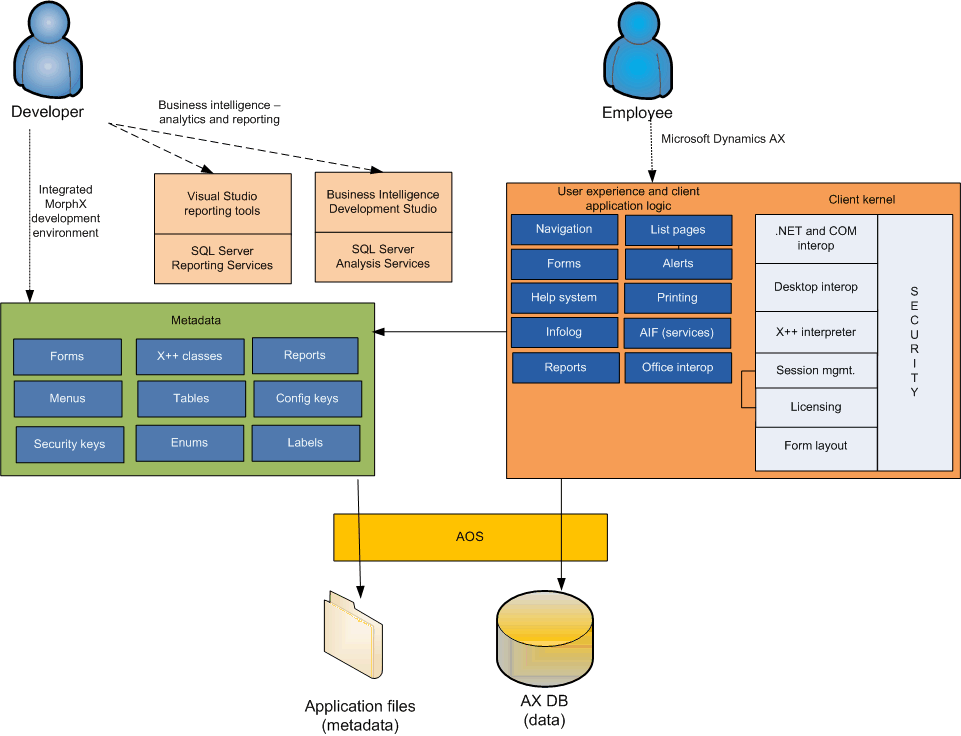This topic describes the high-level architecture of the Microsoft Dynamics AX Windows client.
 Microsoft
Dynamics AX Windows client
Microsoft
Dynamics AX Windows client
The client application is a 32-bit Windows application that provides a rich user interface for the Microsoft Dynamics AX application. The client is typically used for employees or users within the organization. You can use the Enterprise Portal for browser-based access by external users or for users who do not require the rich user interface offered by the Windows client.
 Note
Note
|
|---|
|
You must have the minimum network latency and bandwidth to get proper performance from the client. The client is a chatty application, and you may experience performance issues with response time without the minimum network requirements. For more information on system requirements, see System requirements Web page. |
Client functionality
The client provides the following functionality:
-
Rich user interface.The client provides a rich user interface for users with over 2,500 forms. The Microsoft Dynamics AX forms use X++ to process events and business logic.
-
The MorphX development environment.The development environment is integrated into the client application. Any authorized developer can use the client application as the MorphX development environment to enhance or customize the Microsoft Dynamics AX application.
-
Integration with Microsoft Office.The Microsoft Dynamics AX application integrates with Microsoft Office. For example, you can export data from grids on every form to Excel. You can integrate Outlook with the CRM module to synchronize schedules and tasks bi-directionally.
-
Unified communications.The client provides integrated unified communications using the Microsoft Office Communicator. Key forms and controls are presence-aware for contacts and employees. These forms and controls provide visual presence showing the availability and willingness of the contacts. Users can also use real-time messaging such as instant messaging and voice communication.
-
Integration with the Telephony Application Programming Interface (TAPI).TAPI is a Microsoft Windows standard interface for integration between telephone systems and Windows-based software. For example, your application displays information about the caller when you receive a call. The Microsoft Dynamics AX client supports TAPI.
-
Reports.The Microsoft Dynamics AX application provides two types of reports, standard reports and reports based on SQL Server Reporting Services (SSRS).
Client/Server communication
The client communicates with various Microsoft Dynamics AX components as follows:
-
The client uses the remote procedure call (RPC) protocol to directly communicate with the Application Object Server (AOS). The client never accesses the database or metadata directly. The AOS sends the application objects and data to the client.
-
The client uses a report control Web Part to interact with the report server. The report control calls the Web services exposed by the report server to display information contained in SSRS-based reports. These reports can include either transactional data from the Microsoft Dynamics AX application or OLAP cubes providing the business analytics and key performance indicators (KPIs) from SQL Server Analysis Services.
-
The client provides workflow forms, alerts, and controls that users can use to participate in the business process using the Workflow system, a Microsoft Dynamics AX component to enable workflow processes using Internet Information Services (IIS) and Windows Communication Foundation classes.
-
The client also provides role centers or role-based home pages for users. These role centers provide role-specific tasks, activities, alerts, reports, and business intelligence to users to increase their productivity. The client uses a browser control to interact with the role centers which are part of the Enterprise Portal and are hosted on IIS.
The following diagram describes the high-level client architecture.






